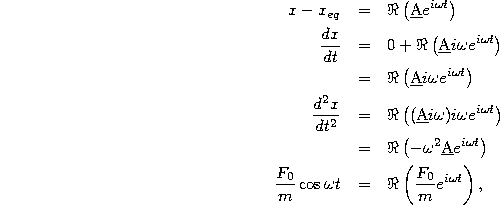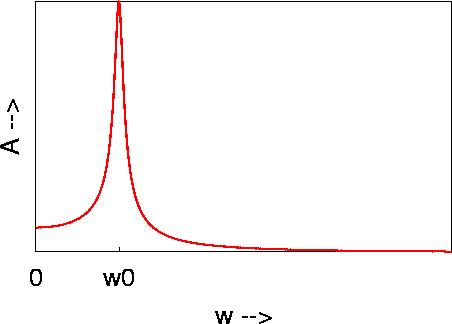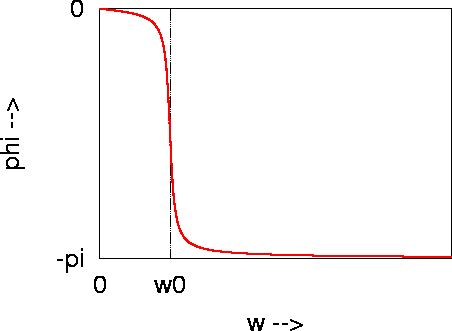
This now is a valid equation of motion. Simplifying by dividing through by m and rearranging a bit, we find
where we have defined the natural frequency of the system as ![]() as above in (7).
as above in (7).
where, as above, we define ![]() .
.
To verify this as a solution and to identify the appropriate value of
![]() , we substitute (36) into the equation of
motion. As usual, we first evaluate the useful terms before
substituting:
, we substitute (36) into the equation of
motion. As usual, we first evaluate the useful terms before
substituting:

where, in the last step, we use Euler's formula to get the driving force term into a form similar to all of the other terms. Substituting all of these terms into the equation of motion (34), and collecting terms we find
To complete the argument, we note that the left hand side of
(37) describes an oscillation of amplitude ![]() , whereas the right hand size is zero. This equation
holds for all time t if and only if the amplitude of the oscillation
on the left-hand size is zero. Thus, the equation of motion is
satisfied by our solution, but only if
, whereas the right hand size is zero. This equation
holds for all time t if and only if the amplitude of the oscillation
on the left-hand size is zero. Thus, the equation of motion is
satisfied by our solution, but only if
![]()
or, solving for ![]() ,
,
where we have used the fact that complex numbers
![]() and
and ![]() always may be decomposed into amplitudes and phases,
always may be decomposed into amplitudes and phases,
![]() and
and
![]() .
From the final line of (39), we learn two simple rules:
(1) the magnitude of
a quotient is the quotient of the magnitudes, and (2) the phase of a
quotient is the difference of the phases. Mathematically,
.
From the final line of (39), we learn two simple rules:
(1) the magnitude of
a quotient is the quotient of the magnitudes, and (2) the phase of a
quotient is the difference of the phases. Mathematically,

Thus, in our particular case,
and,
Figures 6 and 7 plot these results for the amplitude and initial phase, respectively.

Figure 6: Amplitude (A) of driven, damped harmonic oscillator as a function
of drive angular frequency (w)

Figure 7: Initial phase (phi) of driven, damped harmonic oscillator
as a function of drive frequency (w)





